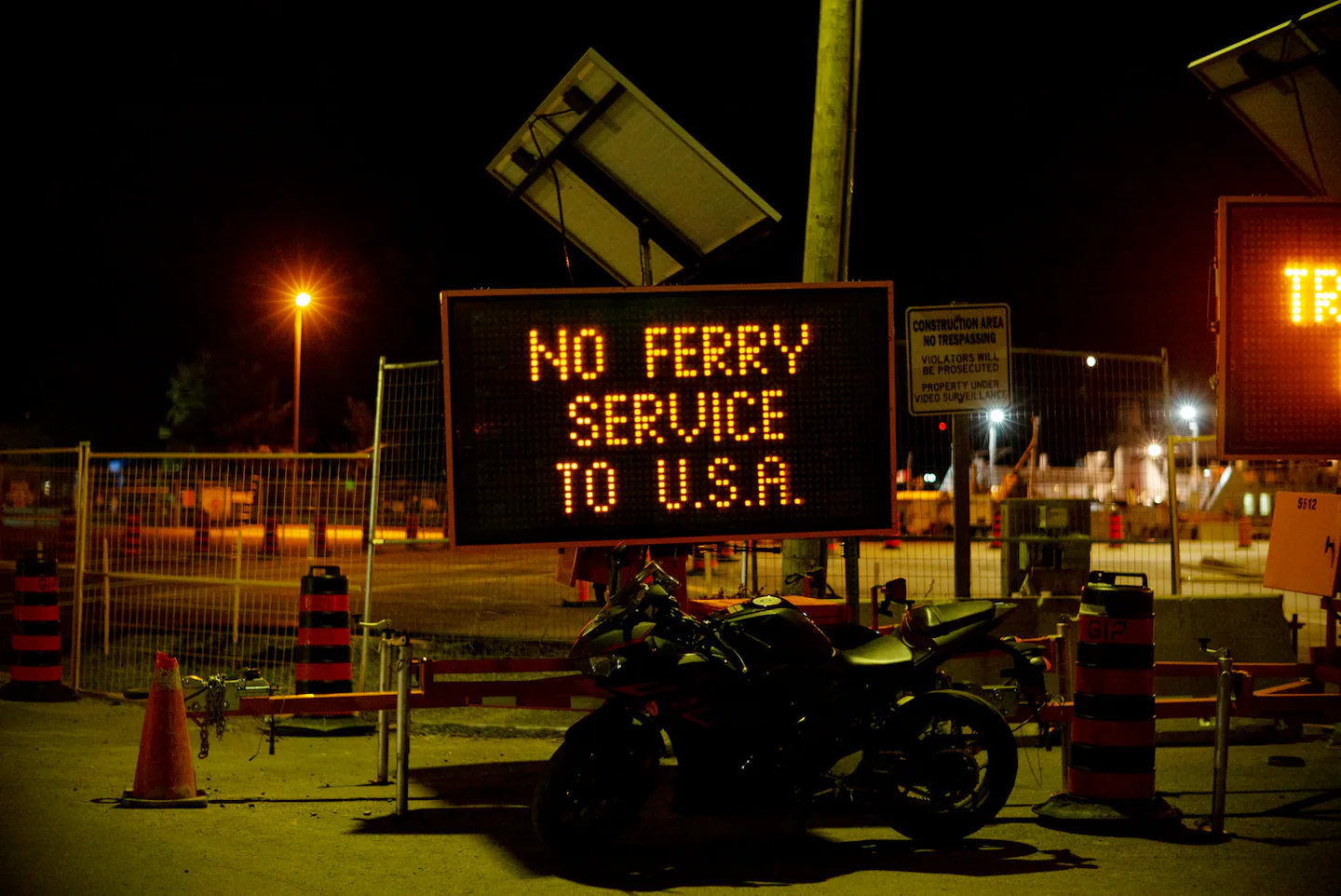
Previously, only the Sept. 11 terrorist attacks and the COVID-19 pandemic border closing had halted the Horne ferry service. And despite the current tensions between the two countries, Bruce Horne, who helped run the ferry for 43 years before retiring, says he hopes the ferry will run again. So do politicians on both sides of the border.
“It’s a shame to lose this connection between Wolfe Island and the Cape,” Horne said as he stood at the end of the wharf, its sign in pieces on the ground, torn apart by a windstorm. “We always hear how ignorant the Americans are of Canada. But it’s not true for northern New York state. There’s a closeness to our communities.”
Wolfe Island is 48 square miles, more than double the size of Manhattan, but only about 1,600 people live there year round. With two schools and a single village, traffic is scarce on the narrow roads, many unpaved, that pass by small farms.
The island sits where Lake Ontario flows into the St. Lawrence River, near one end of an archipelago known as the Thousand Islands. (It has between 1,149 and 1,849 islands, depending on how generously “island” is defined.)
The border, characterized by zigzagging lines through the river, was the subject of repeated disputes after both the American Revolutionary War and the War of 1812. It was not until 1822 that a commission finally resolved the issue.
Many people on Wolfe Island, including the Hornes, are descendants of British loyalists who came after the American Revolution. (Canada was not a nation until 1867.) Many have family members or close friends across the border in New York, which had been a 10-minute ferry ride away.
Though islanders miss the Horne Ferry, its absence is more inconvenience than crisis. Their main connection to the world are two large ferries owned by the province of Ontario that run between Wolfe Island and Kingston, a Canadian city with two universities, a military base and an imposing 19th-century fortress.
Bob Albin of Lewisburg, Pennsylvania, first visited Wolfe Island 12 years ago and has returned repeatedly for vacations since. This month, the trip there with his wife, Katherine, and Janet, their daughter, took about an hour longer than usual. He had to cross a bridge into Ontario and take the ferry from Kingston to reach the island.
“But it’s also taken away the fun factor,” Albin said of the ferry’s closing. “When you come across the ferry from Cape Vincent, it’s so idyllic. We missed that.”
The Albins were dining at the Wolfe Island Pub and Pizzeria in Marysville, known by locals as the Wipp. Along with a bar in a nearby hotel and a general store, it is one of the island’s only gathering places.
As he refilled a cooler of soft drinks, James Kirkham, the Wipp’s owner, said the ferry shutdown had also eliminated one category of customer: people who crossed from the United States and then popped in to his restaurant while awaiting the ferry to Kingston.
“It’s just been so much part of our culture and history that not having that as a link to Cape Vincent has been very missed,” Kirkham said, though he acknowledged that few Canadians seemed interested in visiting the United States since President Donald Trump returned to office.
“We definitely want it back,” he said. “The numbers show that Americans are still coming to Canada, big time.”
The Horne family did not start the business. Accounts vary, but it appears to have been licensed in 1802 as a rowboat service run by Samuel Hinckley. The arrival of the railroad to Cape Vincent in 1852 increased demand for the ferry, which also had contracts from the Canadian government to transport mail. Farm produce and fish also made the crossing, though the business was not so lucrative that the Hinckleys could afford to give up farming.
The Hornes, related to the Hinckleys by marriage, gradually took over the ferry service. Barges replaced rowboats. And in 1952, a ferry called the William Darrell, the given names of the Horne brothers who ran the service until 1950, was built to carry about 11 cars.
Bruce Horne, 75, spent his childhood and teenage years on the boat, never intending to make it his life’s work — he had planned to become a geologist. But his father died while he was still in college. After graduating, he got his captain’s papers and began making 22 daily trips across the river from May to October, each day shoehorning a total of 150 to 300 cars onto the ferry’s deck.
Sitting unused in its offseason berth, the William Darrell still appears fit to sail, even if Horne laments that it hasn’t received its annual paint job to cover up marks left on its deck by car tires.
It is unknown when it might be back on the river, though.
The village of Cape Vincent agreed this month to pay $225,000 to buy the American wharf to help preserve the ferry service. Negotiations over the Canadian dock with the municipality that includes Wolfe Island are ongoing. Canada Border Services Agency has indicated that it won’t authorize restarting the ferry until the dilapidated customs shack on the Canadian wharf, dating back to at least the 1960s, is replaced. Horne said that could cost as much as 400,000 Canadian dollars (about $290,000).
Additionally, it remains unclear who would buy the William Darrell and pay for its inspection and registration.
Since the pandemic, Horne said, the ferry had run at a loss.
As much as Horne wants the ferry to fire up its engine, he has no intention of going back to work after 10 years of retirement.
“When we were growing up, it was the center of the universe,” Horne said. “People would come over here for a picnic or go around there on their bicycle. It’s just where everything was happening.”



